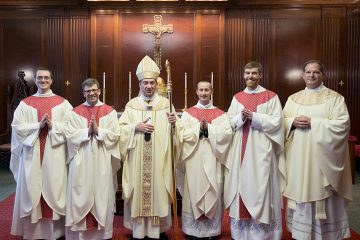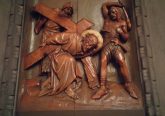Fr. David Endres – Question of Faith Are statues “graven images”?
 Q: One of the most difficult things to explain to my non-Catholic friends is why we decorate our churches with statues. They say they are graven image, and some even reject statue art in museums and engravings on coins. They are especially critical of the crucifix. How can I respond?
Q: One of the most difficult things to explain to my non-Catholic friends is why we decorate our churches with statues. They say they are graven image, and some even reject statue art in museums and engravings on coins. They are especially critical of the crucifix. How can I respond?
A: The first of the Ten Commandments, “You shall not have other gods beside me” includes a prohibition against making “an idol or a likeness of anything in the heavens above or on the earth below or in the waters beneath the earth” (Exodus 20: 3-4). Protestant versions of the Bible often emphasize this particular prohibition against “graven images” by numbering it as the second commandment, while Catholics view the prohibition as included in the first commandment.
Graven images and artwork, whether sacred or secular, are not the same. Graven images are idols used as an object of worship. Art, on the other hand, is an expression of the artist’s skill or imagination by which he or she reflects beauty or expresses or elicits emotion. Whether the manifestation of art is a crucifix, statue, painting, or stained glass window, the image points to something beyond itself.
Art – even sacred art that depicts Jesus, the saints, or angels – is not an object of worship; rather it is a way to direct our minds to worship and veneration. Worship is proper only to God, but God gave us the artistic, creative means to remind ourselves of His presence and to lift our minds and hearts to prayer through art.
In the Scriptures, there is evidence that God commanded Moses to make a bronze serpent as protection against the “fiery” seraph serpents who had bitten the people: “Moses prayed for the people, and the Lord said to Moses: Make a seraph and mount it on a pole, and everyone who has been bitten will look at it and recover. Accordingly, Moses made a bronze serpent and mounted it on a pole, and whenever the serpent bit someone, the person looked at the bronze serpent and recovered” (Numbers 21:7-9).The bronze serpent crafted by human hands was a reminder of God’s power to heal and protect.
When God commanded Solomon to build the Temple, he told him to make two cherubim in the inner sanctuary (1 Kings 6:23). The statues of the angels were reminders that God’s angels are present to watch over us and protect us. Indeed, their protection is so powerful as to be trusted within the Lord’s sanctuary.
Catholic artwork, in particular, celebrates the communion of man and God, seen especially through Jesus, the angels, and the saints. Some have compared our sacred art to that of having pictures of our family members, including those who have gone before us, in our homes. Their images on walls and mantels serve to honor them and preserve their memory. In a similar way, we venerate the saints because they serve as models and powerful intercessors before God.
In artistic representation, the relationship between God and man is powerfully shown in the crucifix. Here we see “God made man” who died for our salvation. The sculpted wood or metal of the crucifix visually communicates that synopsis of Christian belief found in John 3:16: “For God so loved the world that he gave his only Son, so that everyone who believes in him might not perish but might have eternal life.” We do not worship the crucifix, but we cherish this particular image as a reminder of how much God loves us.
It is incorrect to suggest that God has commanded us to reject sacred art because it is a “graven image.” Instead, He invites us to use our talents and energies to create beautiful representations of the holy. God does not prohibit the crafting of statues and paintings, but He does command us not to worship them or consider them more than what they are: reminders of His presence.













